Editor’s note: This article has been corrected. Summer Intersections is Thursday, Aug. 3.
At Case Western Reserve University, undergraduate students don’t waste any time getting into the lab. Across disciplines, research is an integral part of their campus experiences—allowing them to make contributions in fields from engineering to neuroscience to biology and beyond.
That work doesn’t stop over the summer. Many students remain on campus to continue their research—or get started on new projects alongside faculty researchers. To honor these students’ efforts and to give them experience in presenting to large, multidisciplinary audiences, the Office of Support for Undergraduate Research and Creative Endeavors (SOURCE) hosts Summer Intersections.
During this event, undergraduate researchers who have completed projects on campus share their findings with presentations. Summer Intersections is today (Aug. 3) from 10 a.m. to noon at Tinkham Veale University Center. Learn more about Intersections and how you can participate in the future.
We spoke with five students who will present at Summer Intersections to learn about their projects. Answers have been lightly edited for length.
Saad Badat
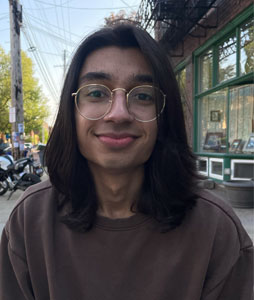
Major: Biology
Year: Fourth year
Project title: “Long-term Live Cell Imaging of Oscillating Stress Granules”
Project faculty mentor: Joseph M. Luna, assistant professor of biochemistry
1. Tell us about your project.
Just like humans experience stress and react to it, cells do too! My project focused on analyzing these stress responses in cells. Cells can exhibit stress responses due to various different environmental stressors. One way in particular is through the formation of stress granules (SG), which are aggregates of RNA and RNA-binding proteins that form in the cytosol.
We have recently observed periodic and sustained SG oscillation in ADAR KO cells exposed to interferon. SG oscillation is when cells repetitively form and then dissolve special clusters, called stress granules. It’s a bit like packing and unpacking a suitcase over and over again, depending on whether the cell is feeling stressed or safe. As these SG oscillations are dynamic in nature, we used a high-resolution imaging approach for the observation and analysis of hundreds of cells over a period of 72 hours.
We quantified SG dynamics charting their number, size, pattern and duration of oscillation. Our findings illuminate the complex nature of stress granule behavior and possess ramifications for stress response regulation.
2. What did you enjoy most about working on this project? What kind of work went into it?
What I appreciated most about this project was the constant process of learning. Even though the experimental setup was relatively straightforward, the depth and complexity of the data analysis provided a constant challenge and an opportunity for growth. I also learned the importance of failure. It is only through failure was I able to refine my methods to accurately analyze my data.
3. Why do you believe students should get involved with Intersections?
Intersections is a great way to celebrate and share your research with others! It also provides a platform where you can communicate with others to network and receive feedback!
4. Anything else you’d like to add?
I want to thank the SOURCE STEM program for funding my project! I also want to thank my amazing lab members at the Luna Lab. If you are interested in learning more check out our lab at lunalab.org.
Lauren Dittrick
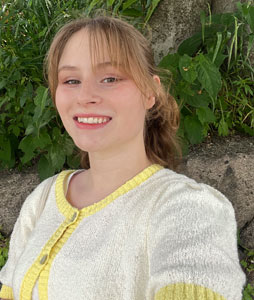
Major: Neuroscience
Year: Third year
Project: “Peptide-Based Rescue of Deficits in the Generation of Myelinating Oligodendrocytes in a Dystonia Model”
Project faculty mentor: Dhananjay Yellajoshyula, assistant professor of neurosciences
1. Tell us about your project.
The basis of research in the Yellajoshyula Lab surrounds the neurological movement disorder dystonia. Dystonia is characterized by prolonged, involuntary, and often painful muscle contractions. In particular, we focus on the childhood-onset form of dystonia called DYT6. Previous studies by Dr. Yellajoshyula have identified loss of function mutations in the transcription factor gene THAP1 as major contributions to the symptoms of DYT6. Oligodendrocytes are the glial cell within the brain and spinal cord (central nervous system or CNS) that are responsible for wrapping a lipid sheath around neurons. This process, coined “myelination,” is similar to insulating a wire. When the neurons are myelinated, it allows for faster neuronal communication. When the THAP1 gene is knocked out (“inactivated”) in oligodendrocytes, these cells are no longer able to myelinate, and the CNS consequently experiences hypomyelination. Additionally, the inactivated THAP1 oligodendrocytes have been observed to secrete an excess of extracellular matrix components, which are inhibitory to the differentiation of oligodendrocytes.
Essentially, the oligodendrocytes surround themselves in a pool of molecules, specifically chondroitin sulfate proteoglycans (CSPGs), which prevent the cell from growing and myelinating.
Using this information as background, my research took a synthetic peptide called intracellular sigma peptide (ISP), which was developed in the Silver Lab here at CWRU. ISP, previously studied in the context of spinal cord injury and neurons, binds to the same receptor as CSPGs. When ISP binds in place of CSPGs, it allows for the alleviation of inhibition caused by CSPGs and facilitates cellular growth. My project took THAP1 knock-out oligodendrocytes and treated them with ISP, with the goal of rescuing myelination deficits seen in the DYT6 model.
2. What did you enjoy most about working on this project? What kind of work went into it?
I really enjoyed getting the opportunity to master immunohistochemistry staining. Throughout this project, I was tasked with staining a plethora of plated oligodendrocytes with various antibodies. This staining technique allowed me to identify which oligodendrocytes were able to mature and which ones were inhibited via CSPGs. Additionally, after the staining was complete, I took photos of the cells with a microscope camera. This portion of the project was really fun, as I got to capture beautiful and bright images of the cells close up. Through the imaging process, I gained an appreciation for the beauty of oligodendrocytes which form complex processes that intertwine with each other and are outlined by a beautiful border of myelin.
3. Why do you believe students should get involved with Intersections?
Intersections provides students an opportunity to present their work in front of individuals who may or may not study within the same academic discipline. Such diversity in your audience is invaluable for the growth of a project and one’s presentation skills. When we as students get in the habit of only presenting our work to those in the same field, we can forget to explain discipline-specific jargon or begin to talk with the assumption that those listening have the same foundational knowledge as us. However, for a project to be successful, the work cannot remain isolated to one field of research.
Germaine Harvey
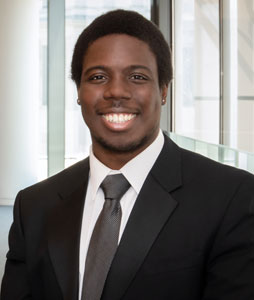
Major: Biochemistry
Year: Fourth year
Project title: “Determining Differences in the Signaling Mechanism Between Thrombin and Cathepsin G Activation of Protease Activated Receptor-4 (PAR4)”
Project faculty mentor: Marvin Nieman, professor of pharmacology
1. Tell us about your project.
I am presenting my work from the Nieman Lab as a part of the Heart, Lung, and Blood research program through Case [Western Reserve]. The project focused on studying the signaling mechanism of a receptor known as Protease Activated Receptor 4 (PAR4) when treated with two different activators: Thrombin and Cathepsin G. PAR4 is on platelets and other cells. It mediates platelet function and is essential to form a stable thrombus (blood clot) in response to vascular injury.
I used cells expressing typical PAR4 or the atypical PAR4-R47Q. Both cell groups were induced with an antibiotic known as tetracycline to express PAR4 and then activated by Thrombin or Cathepsin G. I then used a Western Blot to track the signaling of messengers within the cell to analyze any differences. The blots showed different responses depending on the activator used.
2. What did you enjoy most about working on this project? What kind of work went into it?
Since this project was new, I had to go through the learning curve. I made mistakes at first but learned how to continue to try different methods and to think analytically to troubleshoot problems along the way. I enjoyed the time spent working through and solving problems.
3. Why do you believe students should get involved with Intersections?
Intersections is a great opportunity to share one’s project ideas and get exposed to other sciences that can translate into your work. In addition, Intersections is not restricted to just life sciences and welcomes all who want to share their work. Ultimately, Intersections allow students to showcase and celebrate their dedication to their projects.
4. Anything else you’d like to add?
Thank you to Dr. Nieman and all the members of the lab that have assisted me with this project. I have had the privilege to be in this lab for three years and have learned so much.
Taige Li
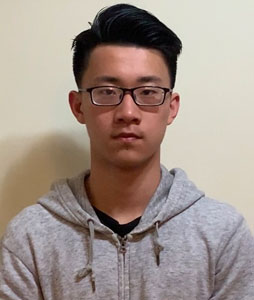
Major: Physics
Year: Fourth year
Project title: “Photoswitching Efficiency of Fluorescent Dyes in Polymer Matrix”
Project faculty mentor: Anuj Saini, visiting assistant professor of physics
1. Tell us about your project.
This project aims to advance the current optical data storage system by improving the photoswitching efficiency of the storage medium. The photoswitching process represents the writing/erasing of data, and we have designed an optical spectral response setup for transmission measurement, as it indicates how the medium has photoswitched.
The setup incorporates a comprehensive array of components, including incident and excitation lasers, to enable precise and accurate characterization of the optical properties of the films in real-time. The findings help us to develop a medium with high energy efficiency and prolonged durability.
2. What did you enjoy most about working on this project? What kind of work went into it?
The process of observing the curves gradually appearing on the screen is truly enjoyable, particularly when the curve aligns with our prediction. However, even when we encounter outcomes that may not conform to our expectations, we are still learning something from it, for within every negative result lies an opportunity to glean insights into the research.
3. Why do you believe students should get involved with Intersections?
Poster sessions help the presenters develop their public speaking and interpersonal skills. They can also build their confidence and connections through these events. Nevertheless, it is often observed that opportunities for undergraduate students to engage in poster sessions remain limited. Intersections is a perfect platform for aspiring undergraduates to enhance their skills and showcase their research, catalyzing their advancement.
4. Anything else you’d like to add?
I’d also like to thank Professor Lydia Kisley for sharing the laboratory space and providing some of the essential equipment required for my research. Her support has been important to this project.
Ben Wellnitz
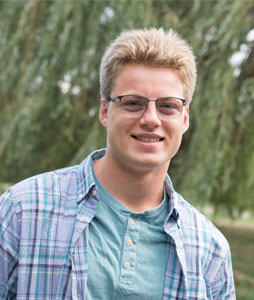
Major: Engineering physics
Year: Third year
Project title: “Improved Imaging at the Nanoscale”
Project faculty mentor: Lydia Kisley, assistant professor of physics
1. Tell us about your project.
My project focuses on improving the super-resolution imaging technique called fluorescence correlation spectroscopy super-resolution optical fluctuation imaging (fcsSOFI, quite the mouthful). Normal optical imaging systems are often limited in the resolution they can achieve because the physical effects of the diffraction of light will blur the image at the diffraction limit of light (In our case this is on the 100s of nanometers scale). In super-resolution imaging we are trying to develop different ways of surpassing the diffraction limit of light, thus allowing us to image things smaller than this scale.
We specifically are trying to image the extracellular matrix (ECM, a porous gel-like structure that cells and proteins must move through- like environments. In the future, imagining techniques for the ECM can lead to a better understanding of how proteins and cells move, allowing for better drug delivery systems. Our method (fcsSOFI), utilizes correlation to understand how fast and where fluorescently tagged proteins are diffusing in a hydrogel. We can then receive structural and dynamic information about the hydrogels. I will be presenting on an improvement to SOFI through the addition of cross correlation, which allows for higher sampling and a better structural understanding of different environments.
2. What did you enjoy most about working on this project? What kind of work went into it?
I enjoy the people the most. There is a group of people in my lab who are all working on improving fcsSOFI, and talking through ideas with them is an absolute blast. It helps us all understand what we are doing better and allows for new ideas to be presented.
Thinking of a new idea by myself may be exciting, but thinking of a new idea with a group is exhilarating for me. When everyone can work together to come up with a complete process, I feel like I have built something together with them.
3. Why do you believe students should get involved with Intersections?
Sharing your work is the most important part of research. If you developed a cure for cancer and told no one, then what was the point? Presenting in a conference is an easy and efficient way for new research ideas to be presented easily and efficiently. Intersections is a low-stress environment where a student can easily get used to presenting their work. It also is just a really cool way to showcase all the hard work you have been putting in.
4. Anything else you’d like to add?
There is a lot more to a research project than what goes onto the poster. So much of the research experience is experimenting with different ways to accomplish your goal, most of which won’t work.
The poster is just a collection of the best-looking parts, which may or may not even be what the researcher is most proud of. There is a lot of work that goes into each and every poster at Intersections and all the student researchers should be proud of what they have accomplished!
